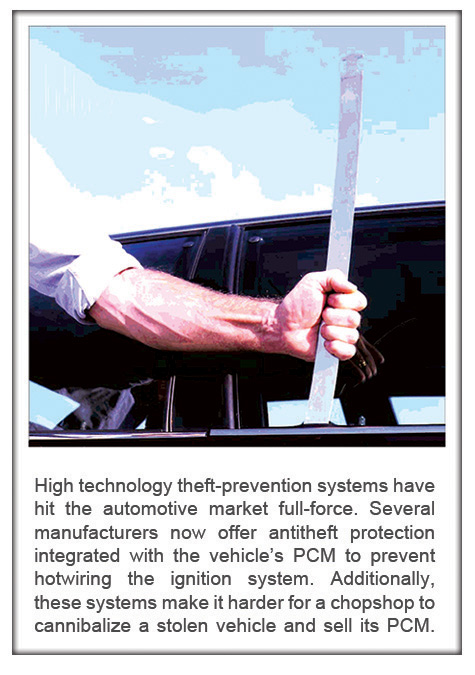
Starting with the all-new 2000 MPV and the redesigned 2000 626, Mazda has incorporated an improved Immobilizer system. The first generation appeared on the 626 in the 1998 model year and continued with the 626 in 1999. A chart with application data for these systems can be found in Figure 1. Let’s call the improved system “Random X.†No, this isn’t the name of the latest rock band. Rather, Random X is an algorithm to generate an unpredictable new number each time the ignition switch cycles. This should prevent someone from stealing a vehicle by copying the ID number of the transponder inside the key.
How do you identify whether a Mazda vehicle has an Immobilizer antitheft system? Vehicles equipped with this system have an Immobilizer icon in the lower right instrument cluster. However, the normal bulb-check before cranking does not flash this icon light. The Immobilizer icon lights for 1-2 seconds after you’ve started the vehicle (refer to Figure 2).
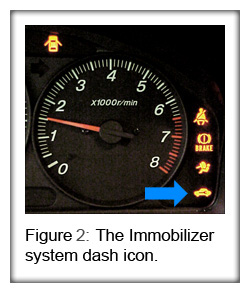
If the engine does not start due to an Immobilizer system fault, the icon flashes a fault code. The icon is also used during Immobilizer system reprogramming. Vehicles with the Immobilizer system have a unique ignition key, different from the keys for vehicles without the Immobilizer system.
The Mazda Immobilizer control unit (CU) shown in Figure 3 and the vehicle PCM use a sophisticated key ID number and digitized codeword to prevent unauthorized vehicle use. ‘Cutting a key’ takes on a whole new meaning both for the customer and for the technician. Besides physically notching the key to match the ignition lock tumblers, you also encode the key’s ID number into the vehicle’s computer.
Refer to Figure 4 to see how the Mazda 626/MPV 2000 Immobilizer system works. I’ve also summarized the steps below:
• The Immobilizer sends an energy pulse via the coil surrounding the ignition switch to charge a capacitor and power up the transponder inside the ignition key.
• The ignition key transmits an ID number to the Immobilizer CU via the coil around the ignition switch. This ID number is unique to each key.
• The ID number must match a value stored inside the Immobilizer CU.
• The Immobilizer sends a random number (X- value) to the ignition key, once again via the coil surrounding the ignition switch.
• The ignition key sends this X-value back to the Immobilizer CU.
• The number received must match the number sent.
• If the numbers match, the Immobilizer sends a codeword and unlock signal to the PCM.
• The PCM verifies that the codeword matches the value stored in the PCM.
• If the codeword matches, the PCM accepts the unlock signal so fuel and ignition pulses can continue.
• The engine can start with any key cut physically to fit the ignition switch tumblers, but stalls within five seconds if the key ID number is wrong or absent. The engine can start and run briefly for three attempts with a wrong key.
• On the fourth attempt to start the engine,
the PCM immobilizes fuel and spark. The Immobilizer icon flashes an Immobilizer code, and the PCM stores code P1624. That car’s not moving under its own power again until you reset the Immobilizer system.
Please note that the vehicle’s PCM is directly linked to the Immobilizer CU. This information can directly affect your troubleshooting methods: Never swap PCM’s to diagnose the cause of a no-start.
Other Security Systems
In addition to the Immobilizer system, the 2000 MPV may have several other security systems. Service information for these systems can be found in the Mazda Workshop Manual, Section 09, Security and Locks group. The Immobilizer system works independently of any of the following security systems:
• Keyless Entry Control Module — Remote-control locking and unlocking of the door locks in addition to a panic button feature on the remote opener,
• Door Lock Control Module — Works in conjunction with the Keyless Entry CM and Theft-Deterrent CM to lock or unlock all doors,
• Theft-Deterrent Control Module — Works with the two modules above and triggers the alarm and lights if a door, trunk or hood is forced open,
• Flasher Control Module — Flashes the hazard warning lights during an alarm after receiving a ground signal from the Theft-Deterrent CM.
The above systems work together to allow remote access to, and provide alarm protection for, the interior of the vehicle. They do not interface with the Immobilizer system in any way.
Battery Condition
If you’re going to attempt reprogramming an Immobilizer system, refer to the appropriate vehicle service manual or other reliable information source. To enter the reprogramming mode, the ignition key must be cycled five times quickly. Once in the reprogramming mode, follow the steps for the item you’re replacing (key, PCM, Immobilizer control unit, ignition switch, etc.). The reprogramming procedures are different for each component.
I can’t overstress the importance of starting with a fully charged battery before proceeding with any key ID number or codeword reprogramming. If the battery voltage drops below nine volts at any time during a reprogramming procedure, you’ll have to start the process over again from Square One. Depending on which procedure you perform, reprogramming can take up to 10 minutes. During this time, the procedure requires you to cycle the ignition switch several times with each key used with the vehicle.
To give you a better appreciation of this system’s complexity, I’ll describe one of several different reprogramming procedures. The reprogramming steps change depending on which component you’re replacing or adding. What’s more, if you have only one or no valid key, the procedure is different from the procedure if you have two or more valid keys.
Complete the following steps to add keys, if you have in hand two or more valid keys:
• Using a valid key, turn the ignition switch ON and OFF five times quickly. Note: The key should not remain in the ON or OFF positions for more than one
second while cycling the ignition switch.
• Turn the key to the ON
position and verify the Immobilizer light stays ON.
• Turn the ignition switch to the LOCK position, remove the key and verify the Immobilizer light went out.
• Insert the second valid key and start the vehicle. The security light should illuminate for one to two seconds, but the engine should continue to run.
• Turn the ignition switch to LOCK and remove the second valid key.
• Reinstall the first valid key and start the engine.
• Turn the ignition switch to LOCK and remove the key.
• Start the engine within 30 seconds using the new key(s). Up to eight keys can be programmed by repeating the above steps.
• After you have programmed the additional keys, wait 30 seconds with the ignition in the LOCK position.
• Now you’re done programming.
Given the time necessary to understand and complete each reprogramming procedure and the time limits for some of the steps, you can understand the importance of beginning with a fully charged battery. The first time I attempted to perform one of these procedures, it took ‘some time’ to get it right. Joking with my co-workers, I bragged that I would stand them a round of beer after work if I had to start over again from Step One while attempting a reprogramming procedure. That boast cost me four buckets of suds.

Troubleshooting A No-Start Vehicle
 First determine whether the vehicle has the Immobilizer system or not. This is harder than it sounds because these vehicles don’t have a large neon sign flashing Immobilizer Inside, so a little research is necessary before jumping to a diagnosis. Take a look at the ignition key. Immobilizer ignition keys do not look like standard Mazda ignition keys (Figure 5a and b). Also look for a coil surrounding the ignition switch (refer to Figure 6).
First determine whether the vehicle has the Immobilizer system or not. This is harder than it sounds because these vehicles don’t have a large neon sign flashing Immobilizer Inside, so a little research is necessary before jumping to a diagnosis. Take a look at the ignition key. Immobilizer ignition keys do not look like standard Mazda ignition keys (Figure 5a and b). Also look for a coil surrounding the ignition switch (refer to Figure 6).
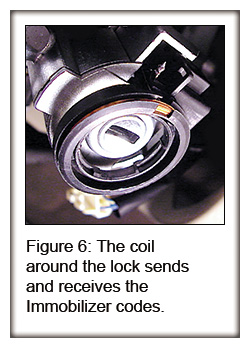
If the no-start vehicle has the Immobilizer system but the Immobilizer light in the lower right hand corner of the instrument cluster is OFF (neither flashing, nor ON steadily), don’t point an accusing finger at the Immobilizer system just yet. Check for PCM-related codes and diagnose the no-start using the same methods you would use if you were tackling a conventional fuel, spark or compression problem.
If the Immobilizer light is flashing, identify the fault code by counting the flashes. The fault codes follow the conventional long-flash/short-flash format. Refer to the shop manual’s troubleshooting procedures for further information on the stored fault code.
I recently diagnosed a no-start 2000 MPV with a flashing Immobilizer light showing a Code 11. This code is for an open circuit between the Immobilizer unit and the coil.
Note: There is no way to extract fault codes directly from the Immobilizer control unit. Faults detected by the Immobilizer system are only displayed by the flashing light in the instrument cluster at the time the fault is active. This means fault codes aren’t stored after the ignition is turned off. Sound familiar? This is a throwback to early Bosch ABS or EZK ignition system fault-code diagnosis.
You can also access Immobilizer-related P1 codes using the Mazda New Generation Star (NGS) Tester. These P1 codes do not illuminate the MIL and can’t be accessed with a generic OBD-II codereader.
But don’t fret, Immobilizer-related P1 codes stored in the PCM include key ID number or codeword mismatch faults. Most of these P1 codes have a corresponding Immobilizer flashing fault code. The only exception is a Code 11 for an open in the coil circuit. There is no corresponding P1 code for this Immobilizer flash code.
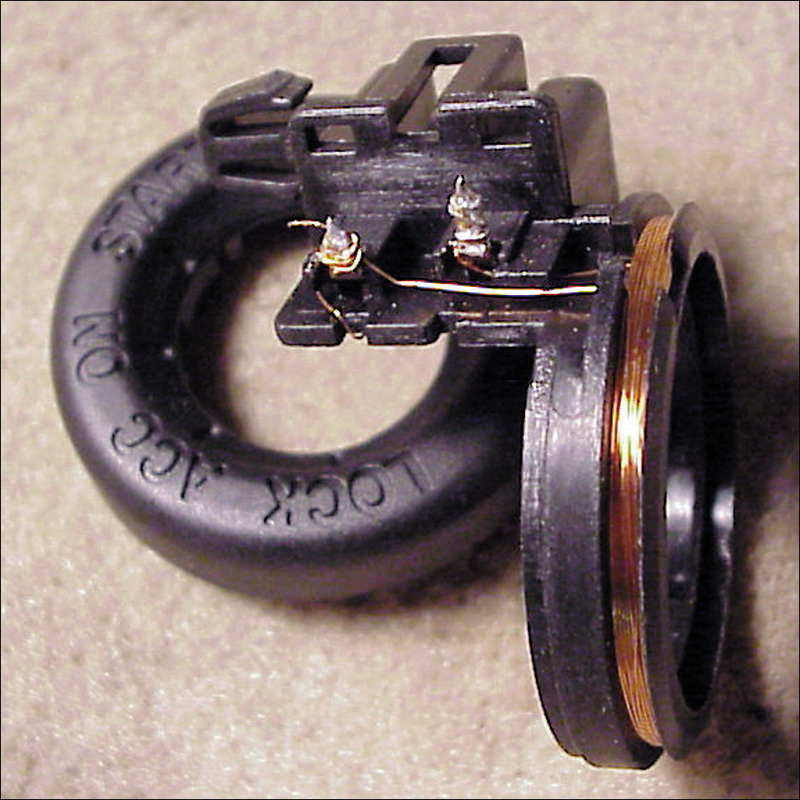
Figure 8: the business end of the Immobilizer coil. It powers the key’s transponder and exchanges information.
Using the NGS Tester with a Version 8 diagnostic card, I also pulled a P1624 code (refer to Figure 7). The definition for this code is: Immobilizer System Communication Counter = 0. This code is stored in the PCM whenever someone has tried to start the engine more than three times while there was a current Immobilizer fault.
The MPV had an open circuit in the coil wrapped around the ignition switch. Replacing that coil solved the no-start. Refer to Figure 8.
Incorrect No-Start Troubleshooting Procedures
The vehicle will not start if you borrow a PCM from a known-good car in an attempt to eliminate the PCM as the possible source of the problem. The codeword stored in the PCM from another vehicle is different from the one in the no-start car. Fortunately, the borrowed PCM will not be changed in any way, and the known-good vehicle should start normally once your return the borrowed PCM.
Things can get expensive if you install a new PCM in the no-start vehicle without reprogramming the ID numbers and codeword. The no-start vehicle still cannot start after the swap because the new PCM won’t allow fuel and ignition without the right codeword. Besides that, if the new PCM is powered up without following the proper initialization procedure, you won’t be able to properly program the PCM, and it will be rendered useless (a mistake that can only be corrected with money!).
Which Key?
Look at Figure 9, then try to determine which keys are identical. If you said the two keys on the right are the same, you were mistaken. Why? Because although the two right keys in the photo look identical, each contains a different internal transponder. The key on the left is for a non-Immobilizer-equipped vehicle; the middle one is only for 1998-99 626 models; and the one on the right is for a 2000 626 or MPV.
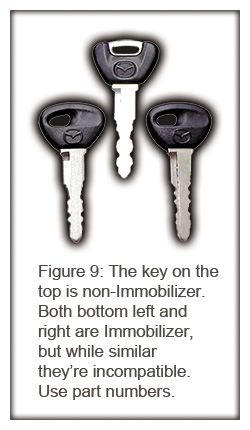
Both Immobilizer keys look the same. However, the transponder for the 98-99 Immobilizer system in not compatible with the system for the 2000 model year. Confusing the two keys causes a no-start and hours wasted trying to figure out why. Make sure you order by the correct part number and that the key remains inside the bag with the part number on it until you are ready to program the keys.
Since the keys from 1998-2000 look identical but aren’t, it is important to order the correct key according to the make and model year. The 1998-99 626 Immobilizer keys are not compatible with the 2000 model-year vehicles, but the 2000 model-year 626 and MPV use the same key. If you are attempting to program an Immobilizer system with the wrong key, your reprogramming will fail. If you are certain you have followed the correct procedures and the battery is fully charged, but the reprogramming failed anyway, order new keys and start over. When attempting to add new keys, be sure to use only the correct ‘known-good’ key; otherwise the system will not work.
by Lester Bravek




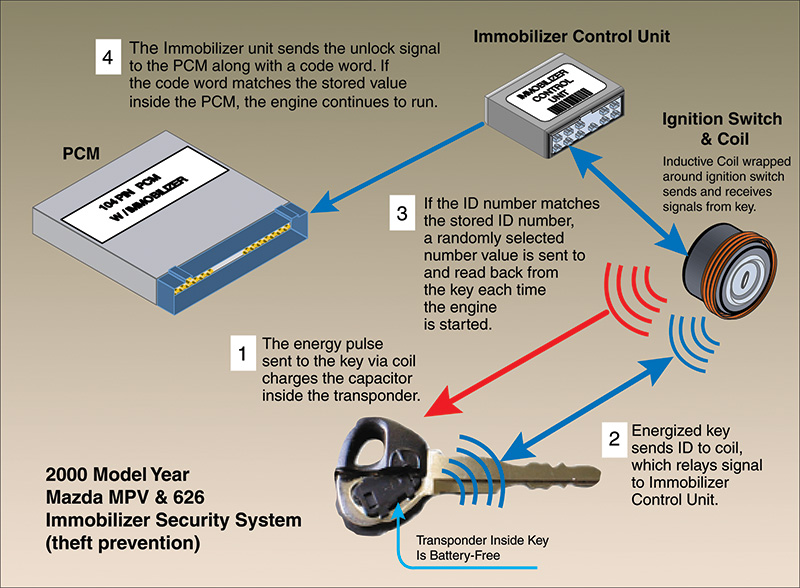
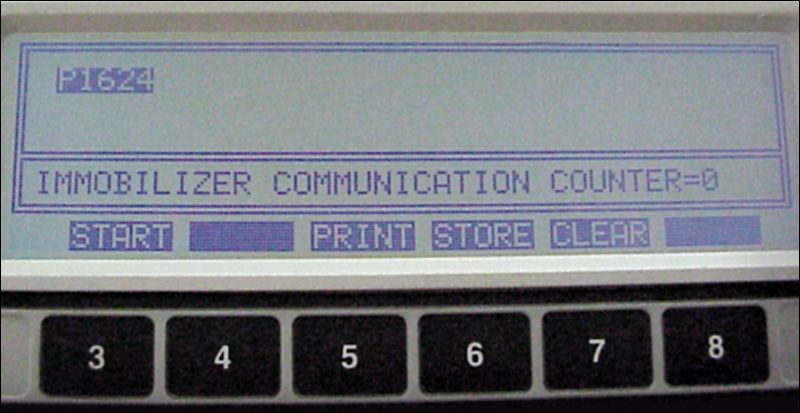



0 Comments